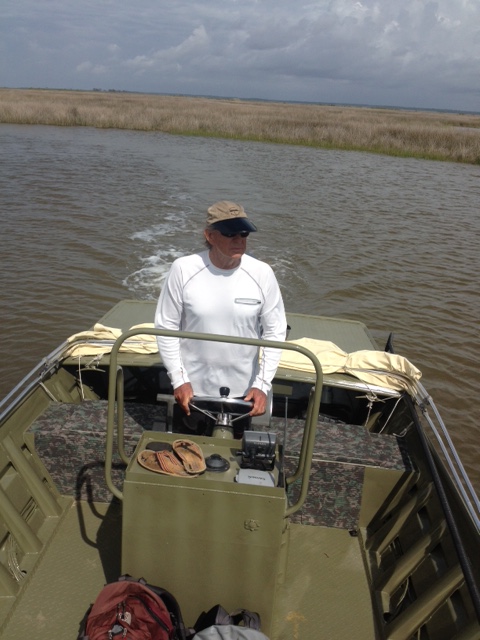
by Rick O'Connor | Dec 17, 2021
Recently I watched a documentary on TV entitled The Loneliest Whale; the search for 52. The title grabbed my attention and so, I checked it out.
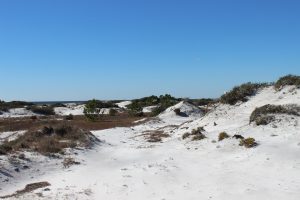
There are many forms of wildlife that are very hard to find in our area. But we continue to look.
Photo: Rick O’Connor
Seems a decade or so ago the U.S. Navy was doing SONAR work in the Pacific between Washington and Alaska and detected a strange sound coming in at 52 hertz. They had not herd this before and would continue to hear it in different locations around the northern Pacific. Their first concern was it was something new from the Russians, but when they showed the graphs and played the recording to a marine mammologist named Dr. Watkins, they found that it was most likely a “biological” – mostly likely a whale.
The problem was that Dr. Watkins had never heard whales calling at 52 hertz. If it was a whale, it was calling a lot – but no other whales were answering. Hence the name “the loneliest whale”. If it was a whale, and no others would talk to it, it was kind of sad. But who was this whale? What kind was it?
Word of the loneliest whale spread around the world and many humans made a connection to this animal, possibly because of their own disconnect with their own species. Stories and ballads were written, and people began to feel for the poor animal that apparently had no friends.
This story caught the attention of a documentary film maker who was interested in finding “52”, as the whale became known. He solicited the help of other marine mammologists; Dr. Watkins had died. According to those marine mammologists, this was going to be VERY difficult. It is hard enough to find just a pod of whales in the open Pacific, much less a specific pod with a specific individual. But they were excited about the challenge of finding this one animal, “52”, and off they went.
As I was watching this documentary it reminded me of my own search here near Pensacola. In 2005, I was asked by members of state turtle groups if I could search to see if diamondback terrapins lived in the western panhandle. This turtle’s range is from Cape Cod Massachusetts to Brownsville Texas, but there were no records from the Florida panhandle. Did the animal exist there? I was running the marine science program at Washington High School at the time and thought this would be a good project for us. So, we began.
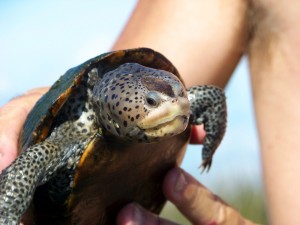
Mississippi Diamondback Terrapin (photo: Molly O’Connor)
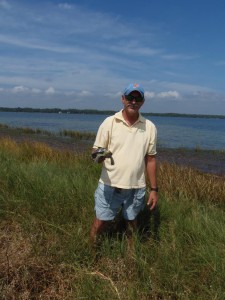
This small turtle can be held safely by grabbing it near the bridge area on each side.
Photo: Molly O’Connor
The students researched terrapin biology and ecology to determine the locations with the highest probability of finding, and we searched. I quickly found that the best time to search for terrapins was during nesting in May and June, and that the worst time to do a project with high school seniors was May and June. So, the project fell on my wife and me. For two years we searched all the “good spots” and found nothing. We placed “Wanted Poster’s” at boat ramps near the good spots with only calls about other species of turtles, not the terrapin.
Then one day in a call came in from a construction worker. Said he had seen the turtle we were looking for. For over a year we had been chasing “false calls” of terrapins. So, I was not overly excited thinking this would be another box turtle or slider. I asked a few questions about what he was looking at and he responded with “you’re the guy who put the wanted poster up correct? – well your turtle is standing next to the poster… it’s the same turtle”. Now I was excited. We did some surveys in that area and in 2007 saw our first terrapin! I can’t tell you how exciting it was. Two years of searching… at times thinking we might work on another project with a different species that actually exists… reading that the diamondback terrapin is like the Loch Ness monster – everyone talks about them, but no one has ever seen one. And there it was, a track in the sand and a head in the water. Yes Virginia… terrapins do exist in the Florida panhandle. The excitement of finding one was indescribable.
We were hooked. We now had to look in other counties in the panhandle, and yes, we found them. As I watched the program of the marine mammologists searching for “52” I could completely relate.
Today, as a marine educator with Florida Sea Grant, I train others how to do terrapin surveys and searches. I let them know how hard it is to find them and to not get disappointed. When they do see one, it will be a very exciting and fulfilling day. Our citizen science program has expanded to searching for other elusive creatures in our bay area. Bay scallops, which are all but gone however we do find evidence of their existence and spend time each year searching for them. In the five years we have been searching we have found only one live scallop, but we are sure they are there. We find their cleaned shells on public boat ramps – by the way, it is illegal to harvest bay scallops in the Pensacola Bay area. Another we are searching for is the nesting beaches of the horseshoe crabs. This is another animal that basically disappeared from our waters but are occasionally seen now. It is exciting to find one, but we are still after their nesting beaches and the chase is on.
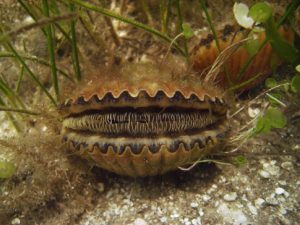
Bay Scallop Argopecten irradians
http://myfwc.com/fishing/saltwater/recreational/bay-scallops/
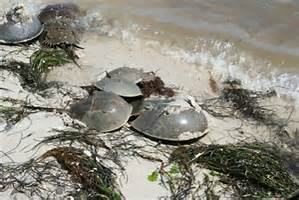
Horseshoe crabs breeding on the beach.
Photo: Florida Sea Grant
I love the challenge of searching for such creatures. If you do as well, we have a citizen science program that does so. You can just contact me at the Escambia County Extension Office to get on the training list, trainings occur in March, and we will get you out there searching. As for whether they found “52”, you will have to watch the program 😊
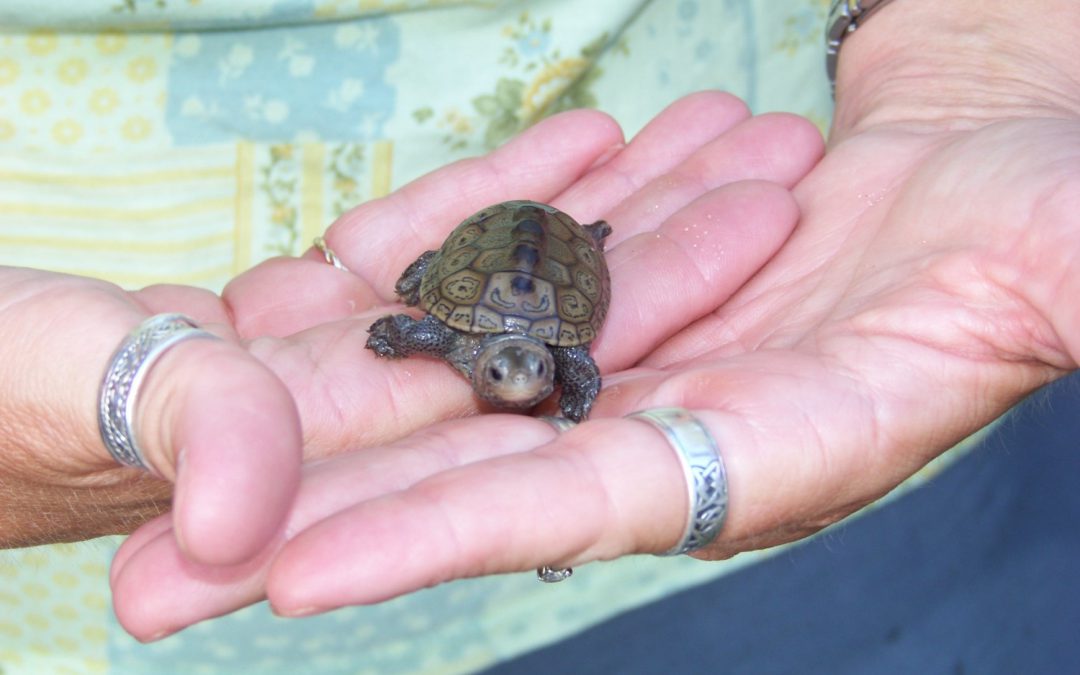
by Rick O'Connor | May 17, 2020
In my time educating the public about Florida turtles I have found that most Floridians have not heard of diamondback terrapins. They have heard of, and seen turtles, but are not sure what the names of the different species are and are not familiar with the term terrapin at all. Which brings up the question – what is the different between a turtle, a tortoise, and a terrapin?
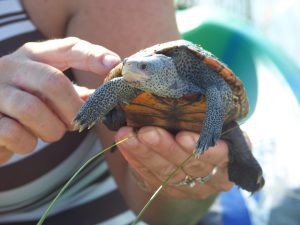
The light colored skin and dark markings are pretty unique to the terrapin.
Photo: Molly O’Connor
Honestly, they are cultural terms and not “biological” descriptions. We associate the term “tortoise” with a land turtle – and this is true – yet we call the box turtle a “turtle” – which is fine. In Great Britain they call almost everything a “terrapin”. The term “terrapin” is a Delaware Indian term meaning “edible turtle”. Most turtles are edible, but this term stuck to a group of brackish water turtles in the Chesapeake area near Delaware we now call “terrapins”.
In the Mid-Atlantic states, terrapins are more known than they are here – and they appear to be more abundant. They are the mascot of the University of Maryland, and the official state reptile there. “Turtle Soup”, a popular cultural dish in the Chesapeake, is made with terrapins. It was served as part of the state dinner when Abraham Lincoln was president – considering it a classic “American” dish. They were harvested by walking through the marshes with a burlap sack and a gig. A sack could bring a harvester about $10, but when the popularity of the dish increased, hand harvesting could not keep up with demand and terrapin farms began. I know there were terrapin farms in the Carolinas, but there was one near Mobile, Alabama as well. Apparently, terrapins existed outside of the Chesapeake – and that brings us back to Florida… we have them too!
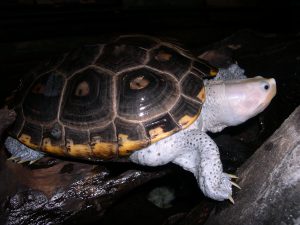
Ornate Diamondback Terrapins Depend on Coastal Marshes and Sea Grass Habitats
There are seven subspecies of this brackish water turtle. They range from Massachusetts to Texas. It is the only resident brackish water species, spending its whole life in salt marshes (or mangroves in south Florida). Florida has five of the seven subspecies, and three of the seven ONLY live in Florida – yet most of us do not know the animal exist.
Very few researchers worked with terrapins in this state – there was virtually nothing known about them in panhandle. In 2005 I began to survey panhandle marshes to see if terrapins existed here. I grew up in the panhandle, and like so many others, had never seen or heard of one. I asked local fishermen who use to gillnet the marshes back in the 1950s and 1960s (when it was allowed) if they were aware of this this turtle. I asked them “did you ever capture a terrapin?” They did not know what I was talking about. And then I showed them a picture… “OH… yea, we did catch these once in a while – what are they called again? Terrapins?”. This was a game changer for me in terrapin education – show them a terrapin and ask if they have ever seen a turtle that looks like this.
The response was still “what is that? It’s beautiful!”… and they are. Terrapins have light colored skin with dark specks or bars – a really pretty cool looking turtle. Oh, and they are in the panhandle, just not in big numbers – or, at least, we have not found them in big numbers 😊.
These brackish water turtles spend their entire lives in a marsh system feeding on mollusk and crustaceans. Like map turtles (their nearest cousins), the females are larger with wide heads for crushing the shells of their prey. They are considered an important member of the ecosystem in that the reduction of terrapins can cause an increase in the marsh periwinkle (a popular snail food) who would in turn stop feeding on leaf litter and attack the live plants themselves – threatening the existence of the marsh. So, they are important predators on marsh grazers. Not having a lot of trees in a salt marsh, you do not see them basking on logs as you do with other riverine turtles. They do, however, exit the water and bury in the mud/sand for long periods to bask.
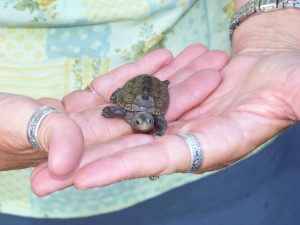
A baby terrapin.
Photo: Molly O’Connor
After mating, the females usually leave the marsh for the open estuary, swim along the shorelines looking for high/dry ground for nesting. More often than not, these are sandy beaches – but they have been known to dig nest in crushed shell mounds, dredge spoil islands, along highways, backyards, and even runways of airports – wherever “high and dry” can be found in a marsh. In Louisiana a lady found one roaming around inside her outdoor shower – good luck nesting there!
The females lay about 10 eggs in a clutch and will lay more than one clutch each year. Baby terrapins are one of the coolest looking turtles you will see. They emerge from the nest in late summer and fall, hiding in the wrack debris along the shoreline. It is believed they actually have a more terrestrial life early on before entering the water and living out their lives in the marsh.
The popularity of turtle soup has waned since the Civil War, as have the wild harvest and aquaculture projects. However, the turtle is still under tremendous pressure from humans. We began using wired crab traps in the 1950s and terrapins have a habit of swimming into these, where they drown. The problem is not that large in Florida, but in the Chesapeake, they have found as many as 40 terrapins in one crab trap! Most of these are “ghost crab traps” – ones that “got away” from the owner but are still harvesting marine live – including crabs. One paper indicated that in the early part of the 21st century, in one year in the Chesapeake, over 900,000 blue crabs died in ghost crab traps – a commercial value of about $300,000. So, the ghost crab trap is a problem whether it kills terrapins, redfish, flounder, or blue crab. Today, many crab traps have biodegradable panels so that if the trap “gets away” it will eventually breakdown and not capture organisms like terrapins. In the Chesapeake many states require crab traps to have a By-Catch Reduction Device (BRD) to keep terrapins out – but allow crabs in. They are not required in Florida, however FWC will provide them for free if you are interested. I have some in my office in Pensacola and more than willing to give them to you. FWC also hosts crab trap removal programs, and I encourage you to participate in these.
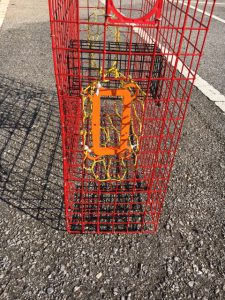
This orange plastic rectangle is a Bycatch Reduction Device (BRD) used to keep terrapins out of crab traps – but not crabs.
Photo: Rick O’Connor
A bigger issue for Florida is the land-based predators. As we moved closer and closer to the salt marshes, we built bridges and roads that allowed land-based predators to reach the nesting beaches they previously did not have access to. Raccoons in particular are a big problem, depredating as many as 90% of the terrapin nests. Poaching for the pet trade is rising and FWC is working on this. Several major arrests have been made in Florida in recent years. It is illegal to sell Florida turtles, so do not buy them if you see them being sold somewhere. Report the activity to FWC.
Due to all of this, terrapins afford some form of protection in each of the coastal states where they exist. Some list them as “endangered” or “threatened”. In Florida, they do not have this label, but they are protected by FWC. No one is allowed to have more than two in their possession, and you are not allowed to have any eggs.
It is an amazing turtle. I currently conduct a citizen science program monitoring them in the western panhandle. I have a lot of eager volunteers wanting to see their first one in the wild. I hope they do soon. I hope they hang around long enough for everyone to see one in the wild.
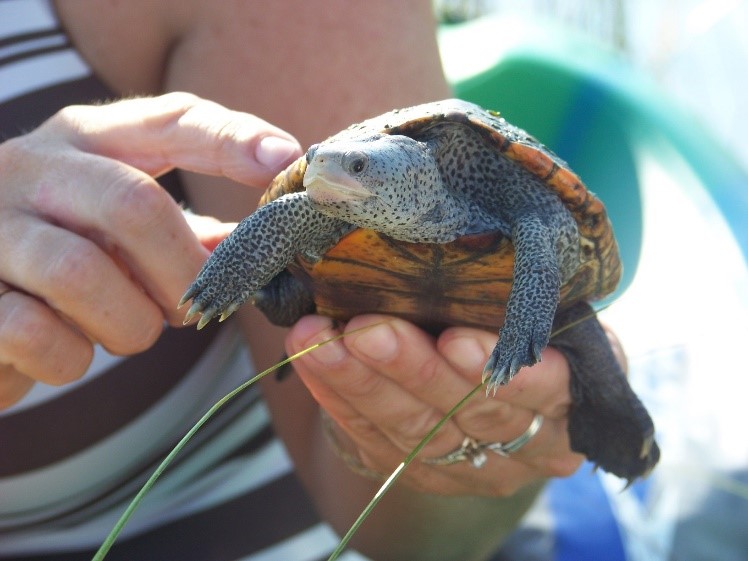
by Ray Bodrey | Apr 17, 2019
Soon, two important ecological surveys will begin in Gulf County, concerning both diamondback terrapins and mangroves.
Florida is home to five subspecies of diamondback terrapin, three of which occur exclusively in Florida. Diamondback terrapins live in coastal marshes, tidal creeks, mangroves, and other brackish or estuarine habitats. However, the diamondback terrapin is currently listed as a Species of Greatest Conservation Need (SGCN).
Diamondback terrapin populations, unfortunately, are nationally in decline. Human activities, such as pollution, land development and crabbing without by-catch reduction devices are often reasons for the decline, but decades ago they were almost hunted to extinction for their tasty meat. The recent decline has raised concern of not only federal agencies, but also organizations and community groups on the state and local levels. Diamondback Terrapin range is thought to have once been all of coastal Florida, including the Keys.
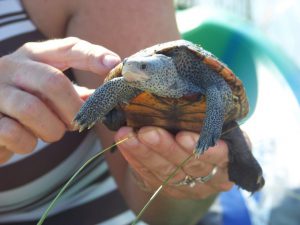
Figure 1: Diamondback Terrapin.
Credit: Rick O’Connor, UF/IFAS Extension & Florida Sea Grant, Escambia County.
Mangroves, a shoreline plant species of south Florida, are migrating north and are now being found in the Panhandle. Both red and black mangroves have been found in St. Joseph Bay. Mangroves establishment could be an important key to a healthy bay ecosystem, as a factor in shoreline restoration and critical aquatic life habitat.
Currently there is a significant data gap for both diamondback terrapin and mangrove populations. Therefore, there is a great need to conduct assessments to learn more about their geographic distribution.
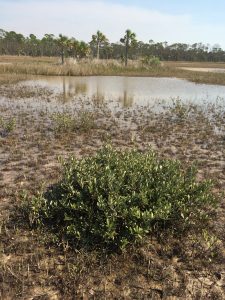
Figure 2. Black Mangrove in St. Joseph Bay.
Credit: Ray Bodrey, UF/IFAS Extension & Florida Sea Grant, Gulf County.
The Forgotten Coast Sea Turtle Center is partnering with UF/IFAS Extension & Florida Sea Grant to assist in surveying and monitoring diamondback terrapins and mangroves in St. Joseph Bay, and we need your help! UF/IFAS Extension & Florida Sea Grant Agent’s Rick O’Connor and Ray Bodrey are providing a training workshop for volunteers and coordinating surveys for St. Joseph Bay. Terrapin surveys require visiting an estuarine location where terrapin nesting sites and mangrove plants are highly probable. Volunteers will visit their assigned locations at least once a week during the months of May and June and complete data sheets for each trip. Each survey takes about two hours, and some locations may require a kayak to reach.
If you are interested in volunteering for these important projects, we will hold a training session on Monday, April 22nd at 1:00 p.m. ET at the Forgotten Coast Sea Turtle Center (located at 1001 10th Street, Port St. Joe).
For more information, please contact:
Ray Bodrey, UF/IFAS Extension Gulf County, Extension Director
rbodrey@ufl.edu
(850) 639-3200
UF/IFAS Extension is an Equal Opportunity Institution.

by Rick O'Connor | Apr 22, 2016
Many folks are putting together a “bucket list” of things they would like to do or see before they can no longer do them. For many interested in natural resources there are certain national parks and scenic places they would like to visit. Other natural resource fans have a list of wildlife species they would like to see.
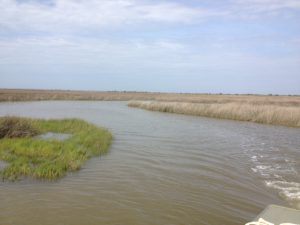
Terrapins inhabit creeks, such as this one, within the expanse of the salt marsh. Here you can see their heads pop up above the water and you may get lucky enough to find one basking.
Photo: Rick O’Connor
Recently I hooked with famed Alabama outdoorsman Jimbo Meador to search for locations to find Alabama turtles. Jimbo has been fishing, hunting, and enjoying the Mobile Bay area all of his life and he now using that knowledge as a guide in a nature-based tourism project. He recently received a call from a group of gentleman from another part of the country who had on their bucket list viewing 1000 reptilian species in their native habitat. In Alabama they were interested in the Black-knobbed Map Turtle, the Alabama Red Belly, and the Diamondback Terrapin. Jimbo has just begun the first module of the Florida Master Naturalist Program and reached out to us for advice on where to find these guys. Luckily, after working with scientists from the University of Alabama at Birmingham, I knew where to find diamondback terrapins – and have a pretty good idea on the others.
These “diamonds of the marsh” – as they are sometimes called – are very elusive creatures. They inhabit muddy bottom creeks within extensive salt marsh habitat all along the Gulf and East coast of the United States. I spent two years searching the Florida panhandle before I found my first live animal. It was one of the odd things though – once you have seen one, you now know what you are looking for and begin to find more.
I took Jimbo to a location near Dauphin Island where about 150 terrapins are believed to exist. Terrapins spend most of their day within creeks that meander through acres of salt marsh. The odd thing is there may be hundreds of creeks within these marshes and the terrapins – for some reason – will select their favorites and hang there. You can spend all day paddling through perfect looking creeks not seeing a head at all… then all of sudden… you enter one creek… not really any different than the others… and there they are.
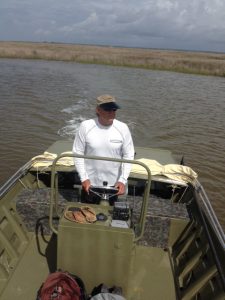
Veteran waterman and outdoor guide, Jimbo Meador, explores the marshes near Dauphin Island for the elusive diamondback terrapin.
Photo: Rick O’Connor
Within these creeks they feed on a variety of shellfish but particularly like the marsh periwinkles. These small snails are the ones that climb the cordgrass and needlerush plants during high tide to avoid their nemesis the blue crab and the diamondback terrapin. Terrapins do crawl out of the water to bask in the sun and have been known to bury in the loose fine mud. Females must find high dry ground to lay her eggs. She may swim as far as 5 miles from her home creek to find a suitable beach. They do like sandy beaches that are open and free of most plants. They emerge onto these beaches during May and June to lay about 7-10 eggs. Most females will lay more than one clutch each season emerging once every 16 days or so. Different from sea turtles – terrapins nest during the daylight hours. Actually the sunnier – the better. Raccoons are a big problem… find and consuming the eggs; on some beaches researchers have reported 90% or more of the nest have been raided by the furry guys. Crows, snakes, and possibly armadillos will take nests as well. If the developing young survive the 60+ days of incubation, they will emerge and head for the grass areas of the marsh… not the water. Here they will spend the first year of their life living more like a land turtle before they make their way to the brackish waters of the salt marsh.
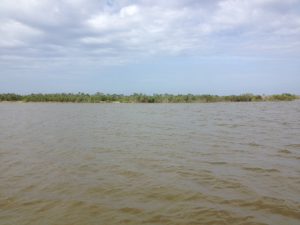
Open sandy beaches, such as the one in this photograph, are the spots females terrapins seek when they are ready to dig a nest.
Photo: Rick O’Connor
These are fascinating creatures and should be on everyone’s natural resource bucket list. The hard effort of finding them really makes doing so very rewarding. On this day Jimbo saw only one head – I did not see any. I have found in my study site that I see more heads in the afternoon (we were out in the morning). I do not know if this is the case at all terrapin nesting sites, but something to consider when looking. Though we did not find many that day he now knows what to look for when searching for them. Next we will have to hunt the Alabama Red Belly Turtle. That is another story for another day.
We will continue this series with other interesting wildlife creatures to “hunt” in the Florida panhandle.
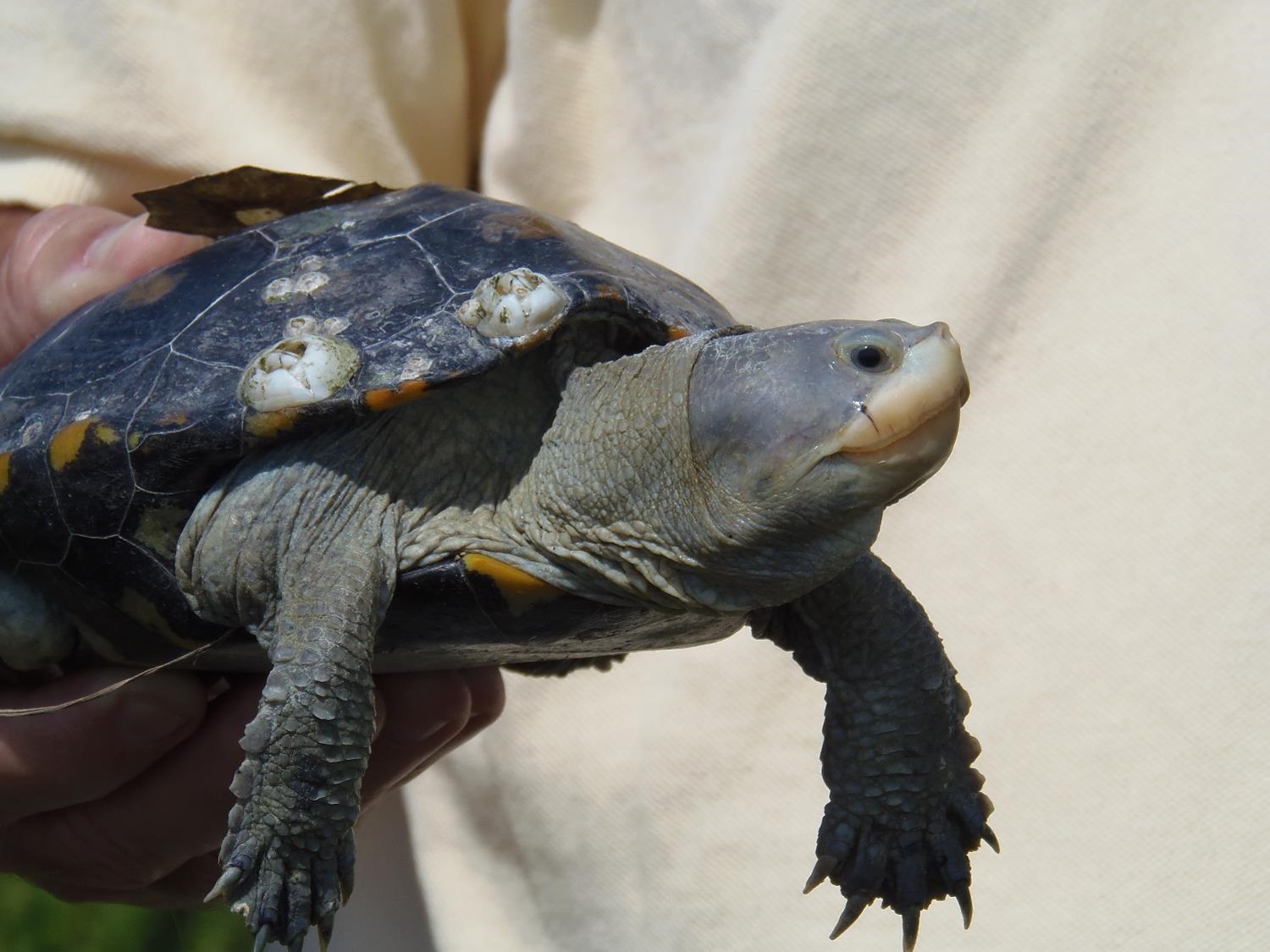
by Rick O'Connor | Oct 2, 2015
They are marvelous creatures and there are very few panhandle residents who know what they are. My wife and I were introduced to Diamondback Terrapins by George Heinrich in 2005. George was the president of a nonprofit, Florida Turtle Conservation Trust, and a member of the Diamondback Terrapin Working Group, a national group of terrapin researchers and educators. He, and these organizations, were very interested in the status of terrapins in the Florida panhandle… so Molly and I took that job on.
Diamondback terrapins (Malaclemmys terrapin) are the only true brackish water resident turtle in the United States. They range from Cape Cod MA down the entire eastern seaboard, across the Gulf of Mexico to Brownsville TX. Within that range there are 7 described subspecies, 5 of those found in Florida, 2 found in the Florida panhandle. These estuarine turtles prefer salt marsh and mangrove habitat. They are very reclusive and difficult to find – hence why most locals have never seen nor heard of them. When I talk about them to the public I get responses such as… “do you mean tarpon?” “I find those in my yard all of the time” (probably a different species), “aren’t those from up north?” and “never heard of them”… they are not fish so they could be found in your yard if you live along the fringes of a salt marsh, they are up north – but they are here also.
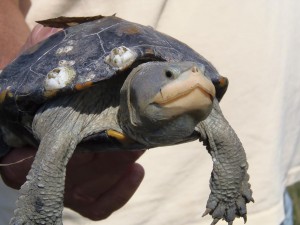
Diamondback terrapin found in Wakulla County.
Photo: Molly O’Connor
In 2005 Molly and I were asked to survey the panhandle and determine if terrapin populations still exist. We decided to take that job on and then expand to determine their population size and whether those populations are increasing or decreasing. The coastal panhandle extends from Escambia County (on the Alabama state line) to Jefferson County (Aucilla River), but due to existing funding we could only survey to the Apalachicola River. This would include six counties: Escambia, Santa Rosa, Okaloosa, Walton, Bay, and Gulf. We verified at least one record of a terrapin in each county. We discovered the larger the expanse of salt marsh – the higher probability of terrapins; thus those counties with relatively little salt marsh (such as Okaloosa) would have fewer/smaller terrapin populations.
But marsh alone is not enough. Terrapins need high ground in which to lay their eggs. High ground within a marsh is not a common thing. Research shows that terrapins will travel up to 5 miles in search of suitable nesting; which means a terrapin could be found in your neighborhood even if no marsh is visible. Unlike sea turtles they are “home-bodies” rarely leaving the marsh where they were born. They spend time forging for shellfish (particularly the snail called marsh periwinkle – Littorina irorata) and basking on and in the mud. They can be seen at the surface with their heads peering at you – they seem to be very curious.
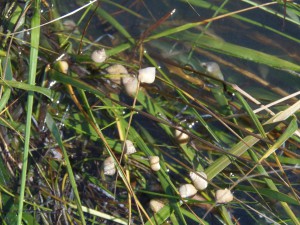
Marsh periwinkles will climb cordgrass to avoid predation by blue crabs and terrapins.
Photo: Molly O’Connor
Once we confirmed that terrapins were still in the panhandle we then began work on how many. To do this we needed to find their nesting beaches. Terrapin nesting season is about the same as that of sea turtles (May 1 – Aug 1); some nesting may occur after that but few. Unlike sea turtles they nest during daylight hours and prefer sunny days over cloudy/raining ones. They like to nest at high tide – thus finding a suitable location that is out of the way of potential flooding by the rising bay – however this does not account for severe storms. They typically lay about 10 eggs in their nest, cover and disguise, and then leave it to its fate. Unfortunately in many nesting areas, its fate is to be uncovered and consumed by predators – particularly raccoons. Molly and I would kayak salt marshes searching for suitable nesting beach. Once found, we would walk the beach looking for sign of nesting. If nesting was found this would be recorded and we would then begin 16-day monitoring trips. It is assumed that each sexually mature female within the population will nest once every 16 days; and they will nest more than once each year. Signs of nesting include tracks (which are counted), and egg shells from a nest that was raided by a raccoon (which were logged and removed). Occasionally we would come across a nesting female. We would allow her to complete the nesting activity and then capture her for measurements and photographs. We would mark her with a notch on the margin of the carapace (top shell) and release her (we did not have the funding for PIT tags). We would also set modified crab traps to capture them. Terrapins have a habitat of entering crab traps (probably more for the bait than the crabs) and becoming entrapped. Unless found within 15-30 minutes, they will drown. Our modified crab traps were tall enough that terrapins could reach the surface (even at the highest tide) and get a breath of air. We would set traps for 5 day periods and (if we caught any at all) would only capture during the first day or two. Terrapins are smart and we found that after day 2 most would approach our traps, observe our handy work, and swim away. With the data from these two activities we could get a rough idea of how many terrapins were in this population and how they changed over time.

The marshy habitat terrapins love.
Photo: Molly O’Connor
We focused our population surveys to our home counties of Santa Rosa and Escambia counties. We were able to identify 1 nesting beach in Escambia and 2 in Santa Rosa (we have since found a 3rd). We never caught a terrapin in Escambia but had good success at one of the two beaches in Santa Rosa. That population had approximately 50 individuals living within it. From 2007 to 2012 the population remained relatively stable. In 2012 I changed jobs and have not had a chance to re-survey. I plan to do this in 2016.
This year we trained 24 volunteers to assist us in locating and monitoring nesting beaches. They did find a new nesting beach in Santa Rosa and will begin monitoring nesting activity and trapping next year.
These are fascinating creatures and one of the most beautiful turtles you will ever see. Some have asked me about state protection for them. They are listed as a freshwater turtle with FWC thus you cannot possess more than two, cannot have any eggs, and cannot sell them.
If you have questions about diamondback terrapins, are interested in participating in terrapin surveys in Escambia and Santa Rosa counties, or would like to begin your own surveys in your county. Contact me (Rick O’Connor) at roc1@ufl.edu or (850) 475-5230.




















